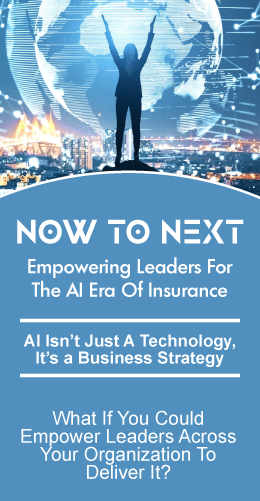
According to Accenture, on average only 25% of an underwriter’s day is spent on selling and broker engagement, while more than 50% is spent on core processing and repetitive tasks like data entry. Imagine if underwriters could spend more time with brokers and customers, and focus on delivering a better customer experience instead of being bogged down by cumbersome, error-prone manual processes? What if you could drive more revenue by increasing your underwriting capacity by 50% – without adding staff?
Market Pressure is Growing – Innovation is Here
Commercial insurance companies today face an array of market pressures including rising customer expectations, increasingly complex risks, soaring underwriting expense ratios, and the ongoing impacts of the coronavirus pandemic. According to Celent[2], 67 percent of large insurers indicated that cost reduction and process improvement had become more important in light of COVID-19.
To address post-COVID priorities, the commercial insurance industry can no longer afford to let manual underwriting processes hinder customer responsiveness and growth. The good news is that with the emergence of technologies like artificial intelligence (AI), commercial insurance carriers have an incredible opportunity to transform underwriting from a cost center to a strategic sales and profit driver.
Transformative innovations like straight-through processing and continuous underwriting will require unprecedented real-time access to policyholder data to rapidly assess and price risk. The challenge is that much of this policy-level data is trapped in digital insurance documents of various types and formats – submissions, binders, quotes, and policies – and 80% of it is unstructured.
Today, the capacity and judgment of skilled underwriters is being squandered on routine, manual tasks, and core data processing that – let’s be honest – computers can do better and faster. By augmenting humans with artificial intelligence and AI-powered automation, carriers can free up underwriting teams to focus on customers and growth.
Automated Application Intake
If you want to improve underwriting efficiency and accelerate turnaround times, start at the beginning with the moment a new submission shows up in the inbox. Today, carriers are heavily reliant on people to extract and analyze data points from insurance submissions to determine if it’s the right business to underwrite.
When brokers send submissions to carriers, the data comes in a variety of formats including Excel and pdf files. Application intake is a messy, labor-intensive, and highly manual process that erodes the productivity of underwriting teams and impedes the speed at which carriers can respond to brokers, agents, and customers.
A lack of automation means that many carriers can only respond to less than half of the submissions they receive. For business that the carrier doesn’t want to write, it is not uncommon for distribution partners to receive no response at all. Going through this process can take days or weeks. The result is a status quo that falls far short of broker and customer expectations for a fast and responsive digital experience.
AI enables insurers to complete a significant portion of the commercial lines underwriting process before a submission ever reaches a human underwriter. Machine Learning and Natural Language Processing (NLP), a subset of AI, enable a machine to read, extract, and understand insurance-specific data points in submissions and other digital insurance documents just like a human knowledge worker – only hundreds of times faster. AI removes the need for underwriters and supporting knowledge workers to sift through multiple documents to manually source the data and insights needed to assess and price the risk.
The extracted data can also be shared through API integrations to auto-populate other core systems downstream for straight-through processing (STP) and faster quote-to-bind. Through the use of machine learning, AI solutions capture feedback from your underwriting team to continuously learn and get better over time.
The Bottom Line
Manual underwriting processes lack flexibility and are difficult to scale and adapt to the new normal of digital insurance operations – a lesson that many insurers learned the hard way when COVID-19 forced everyone to shift to working remotely overnight. Tedious, time-consuming manual tasks like re-keying data into various systems, pushing paper, and waiting for signatures have no place in a post-COVID world in which customers want a touchless, frictionless insurance experience.
AI isn’t magic but it is undeniably powerful. As carriers double down on digital, artificial intelligence and AI-powered workflows will enable them to automate age-old, paper-based manual underwriting processes like submission intake that continue to cause bottlenecks and friction that can be felt across the insurance value chain. When human underwriters and AI work together, it helps drive down loss ratios, power up efficiencies, and improve communications between carriers, brokers, and insureds. Ultimately, this helps carriers write more business faster and deliver better digital customer experience.
Further Reading
We invited 13 insurance industry leaders including Celent, Majesco, Marsh Canada, Novarica, Strategy Meets Action, and Zurich North America to weigh in on the top priorities for commercial insurance underwriting. Their insights provide a roadmap of where digital underwriting is headed.
Download your complimentary copy of our crowdsourced Underwriting Priorities eBook here.
Ron Glozman is CEO and founder of Chisel AI, a provider of artificial intelligence solutions for commercial insurance. Ron is Co-Author of The AI Book (Wiley 2020), the first globally crowdsourced book on the applications of AI across financial services.
[1] Accenture Future Workforce Survey – Insurance: Realizing the Full Value of AI.
[2] “COVID-19: Impact on P&C Insurers’ IT Priorities, Budgets, and Plans (North America edition).” Celent Report, April 2020.







